Scandinavian design is celebrated for its understated elegance, simplicity, and emphasis on natural elements. While the style often leans toward minimalism, the use of texture is key to creating spaces that feel warm and inviting. Scandinavian rugs, with their earthy materials, soft tones, and versatile designs, are perfect for layering texture in your home. Whether it’s a thick wool rug in the living room or a flatwoven piece under a dining table, these rugs bring depth and dimension to your space without overpowering its serene aesthetic.
I first realized the transformative power of rugs when redesigning my own living room with Scandinavian influences. The space initially felt too stark, with light wood floors and neutral furniture. Adding a handwoven jute rug underneath my coffee table instantly grounded the space and introduced a layer of warmth. Later, I layered a smaller, patterned wool rug on top for extra texture and visual interest. This small change made the entire room feel cozier and more intentional—proof that rugs are not just decorative but essential to the Scandinavian aesthetic.
If you’re looking to enhance your home with Scandinavian rugs, this guide will help you choose the best options for layering texture. From selecting the right materials to pairing patterns and sizes, these tips will ensure your space achieves the perfect balance of style, comfort, and functionality.
Why Scandinavian Rugs Are Ideal for Layering Texture
1. Emphasis on Natural Materials
Scandinavian design draws inspiration from nature, and rugs made from materials like wool, jute, and cotton fit seamlessly into this aesthetic. These natural fibers bring warmth and tactile softness to a space while remaining durable and easy to maintain.
For example, a thick wool rug with a high pile adds a plush, cozy feel to a bedroom, while a jute rug’s organic texture is perfect for grounding larger open spaces like a living room or dining area.
2. Neutral and Subtle Patterns
Scandinavian rugs often feature muted colors and simple patterns, such as stripes, chevrons, or geometric designs. These understated motifs make them ideal for layering because they complement other elements of the room without overwhelming the décor.
Pairing a large, neutral base rug with a smaller patterned rug can add depth to your space while maintaining the clean, cohesive look characteristic of Scandinavian design.
3. Versatility for Every Space
Scandinavian rugs come in a wide variety of shapes, sizes, and textures, making them suitable for any room in your home. From large area rugs that anchor furniture to small accent pieces that define a nook, these rugs offer endless styling possibilities.
For instance, a round wool rug can soften the lines of a square dining area, while a runner in the hallway introduces texture and coziness to transitional spaces.
Types of Scandinavian Rugs for Layering
1. Flatwoven Rugs
Flatwoven rugs are lightweight, durable, and perfect for layering. Their low profile makes them ideal as a base rug, especially in high-traffic areas like hallways, entryways, and dining rooms.
Example: A neutral-toned flatwoven cotton rug serves as a base layer under a smaller, plush rug with a pattern for added texture.
2. Shag Rugs
Shag rugs, often made from wool, are a staple of Scandinavian design. Their soft, high-pile texture adds a luxurious, cozy element to any room. Use a shag rug as a top layer to create a focal point in the living room or bedroom.
Design Tip: Place a small sheepskin rug on top of a larger flatwoven piece to bring warmth and dimension to your seating area.
3. Handwoven Jute Rugs
Jute rugs are an eco-friendly option that embodies the Scandinavian focus on sustainability and natural materials. Their coarse texture works beautifully as a grounding base layer in living rooms, dining areas, or under beds.
Example: Layer a soft wool rug with subtle patterns over a large jute rug to create contrast and balance.
4. Geometric Wool Rugs
Wool rugs featuring geometric patterns are a Scandinavian classic. Their timeless designs in neutral tones make them perfect for layering over simpler base rugs, adding interest without clashing with other elements in the room.
Tip: Use a small geometric wool rug as a statement piece in the center of your seating arrangement.
5. Round Rugs for Curves and Contrast
Round Scandinavian rugs, often made from braided jute or wool, add a unique shape and texture to rectangular rooms. They are particularly effective for breaking up rigid lines and introducing softness to the overall design.
Example: Use a round jute rug as a base layer and top it with a smaller, rectangular patterned rug to create a dynamic, layered look.
How to Layer Scandinavian Rugs: Step-by-Step
Step 1: Start with a Neutral Base
Begin with a large, neutral rug as your foundation. This base layer sets the tone for the room and provides a backdrop for the smaller rug you’ll layer on top. Flatwoven or jute rugs work well for this purpose due to their durability and subtle texture.
Tip: Ensure the base rug is large enough to anchor your furniture, such as extending under a sofa or dining table.
Step 2: Add a Textured Top Layer
Choose a smaller rug with a different texture or pattern to layer on top of the base rug. For instance, a plush wool shag rug can contrast beautifully with a flatwoven cotton or jute base.
Design Idea: In the living room, layer a soft wool rug over a jute base rug, positioning the top layer at an angle for a relaxed, Scandinavian-inspired look.
Step 3: Mix Shapes and Sizes
Experiment with different shapes and sizes to add dimension to your space. Pair rectangular rugs with round ones, or use a narrow runner as a top layer to define a specific area. This approach works particularly well in open floor plans.
Example: In a seating area, layer a round braided rug beneath a rectangular patterned rug to soften the space and create visual interest.
Step 4: Stick to a Cohesive Color Palette
Scandinavian design is all about simplicity and harmony, so choose rugs that share a similar color palette. Neutral tones like white, beige, gray, and muted pastels ensure the layers blend seamlessly without overwhelming the room.
Tip: If you want to introduce color, opt for subtle shades like dusty rose or sage green in one of the rugs to keep the overall look cohesive.
Step 5: Accessorize with Purpose
Complete the look by adding complementary elements like cushions, throws, or furniture that tie into the rugs’ textures and colors. For instance, a wool throw on the sofa can echo the texture of a shag rug, while a light oak coffee table complements a jute base rug.
Picture Gallery
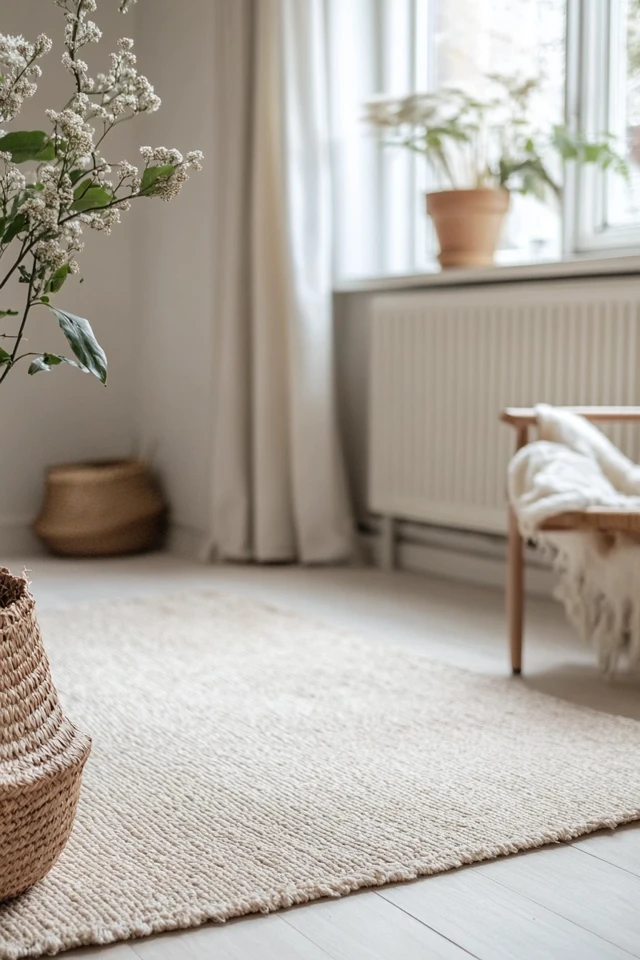
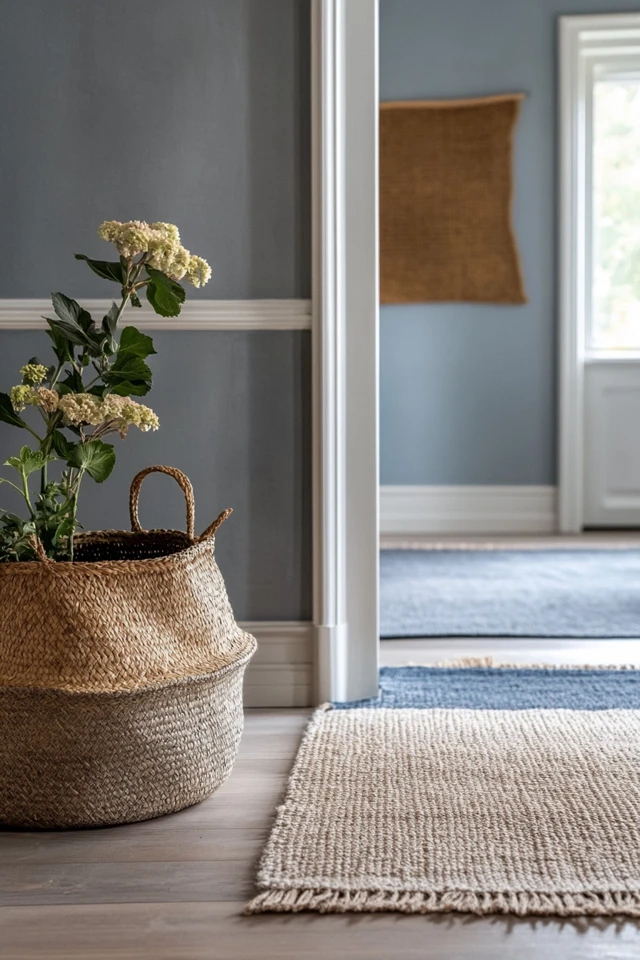
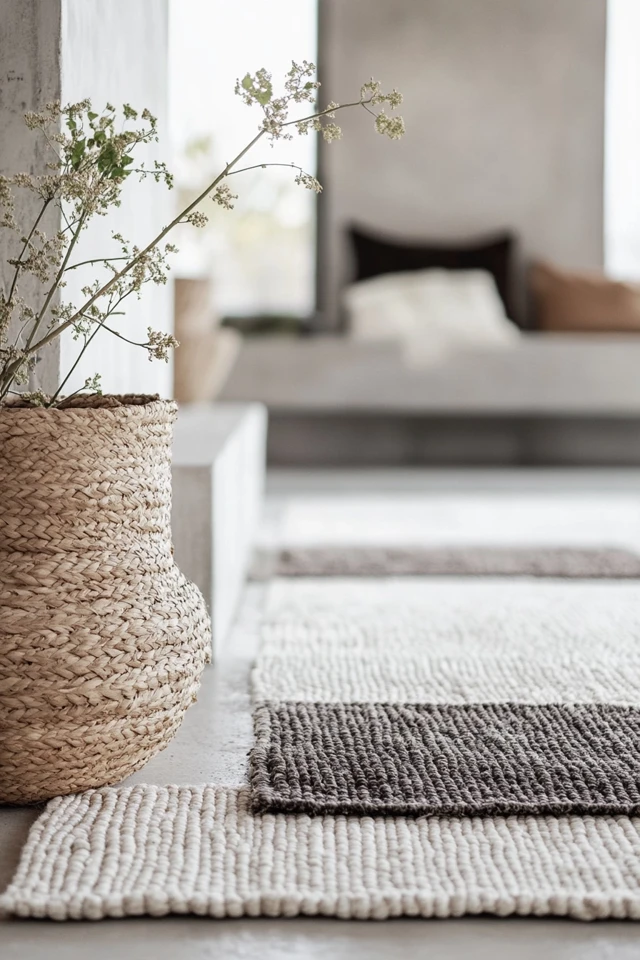

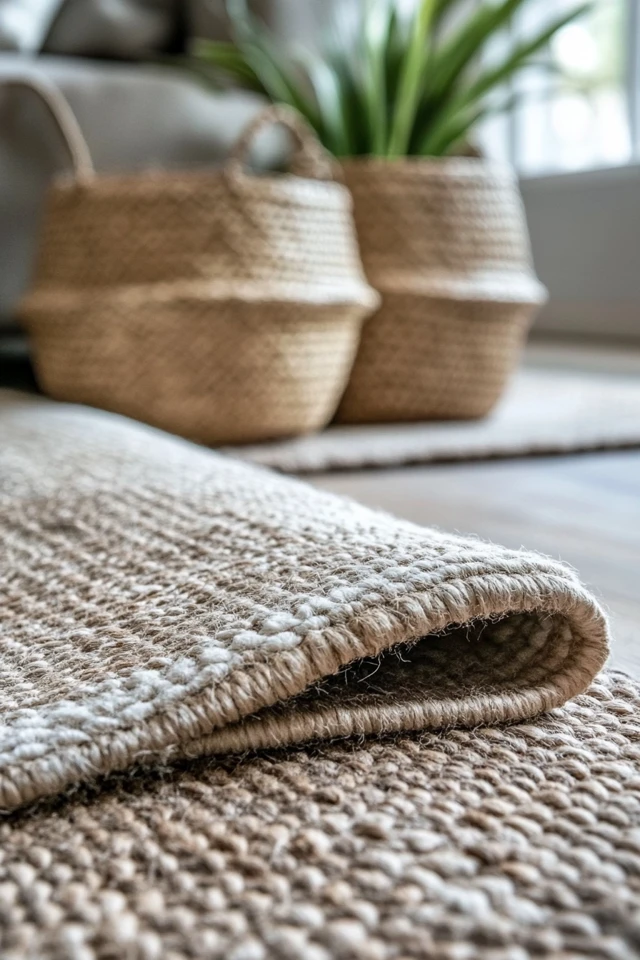
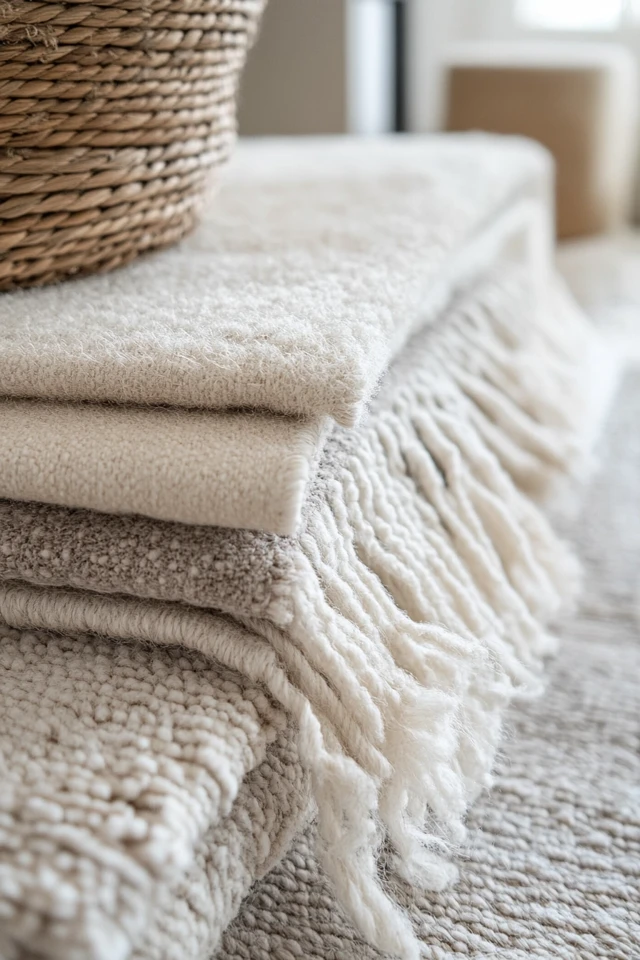
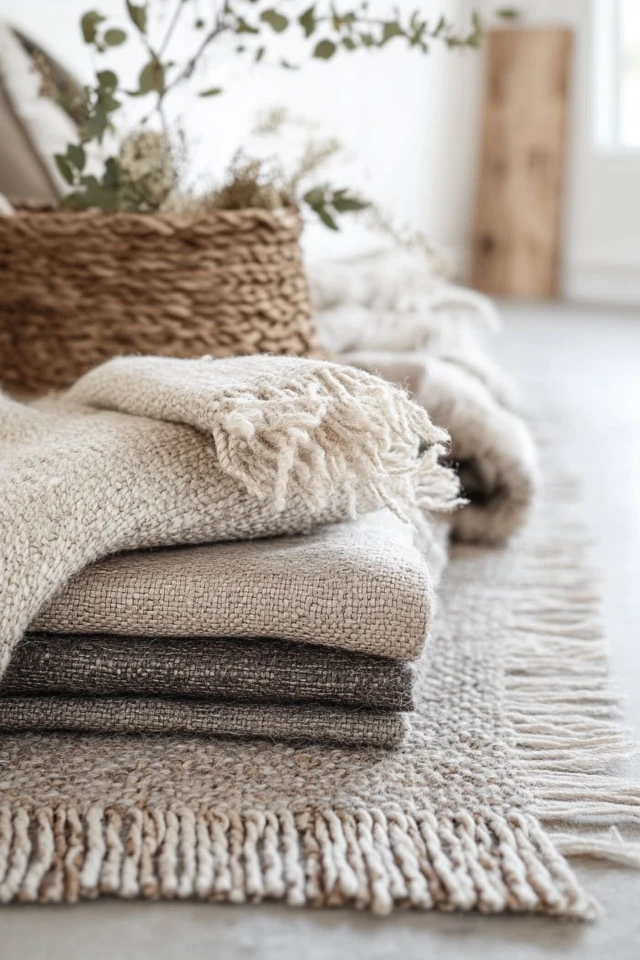
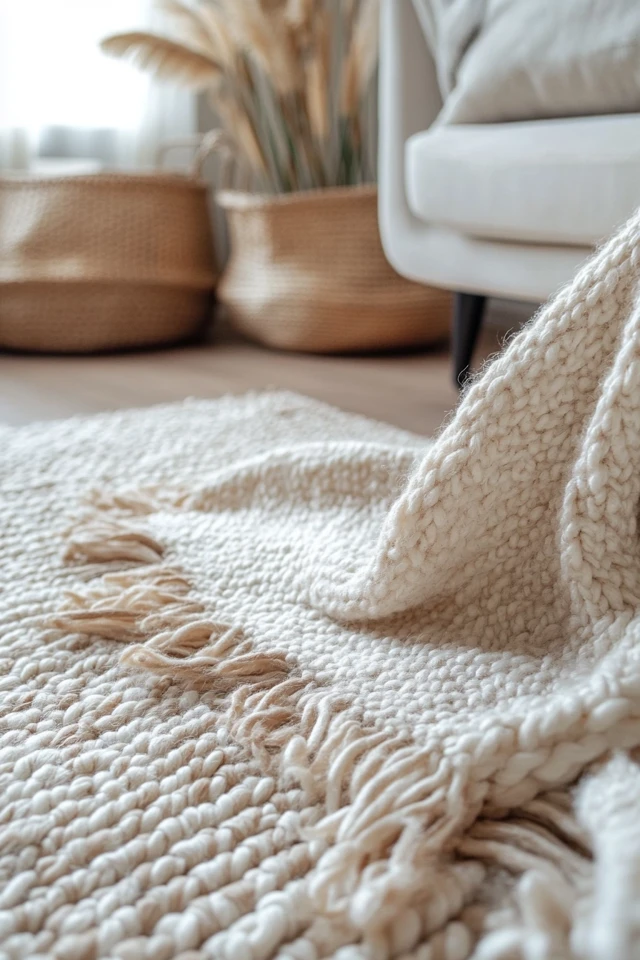
FAQ Section
1. What sizes work best for layering Scandinavian rugs?
Start with a large area rug that defines the space, such as an 8×10-foot jute rug, and layer a smaller 5×7-foot wool or geometric rug on top. The size of the top layer should be proportional to the furniture and space.
2. How do I prevent rugs from slipping when layering?
Use rug pads between layers to prevent slipping and ensure stability. This also adds extra cushioning for a more comfortable feel.
3. Can I layer rugs in small spaces?
Absolutely! Stick to smaller rugs and ensure the layers don’t overwhelm the space. A flatwoven base rug with a small sheepskin topper works beautifully in compact areas.
4. How do I clean Scandinavian rugs?
Regularly vacuum your rugs to remove dirt and debris. Spot-clean spills with a damp cloth and mild detergent. For wool and jute rugs, avoid excess water to prevent damage.
5. What furniture works best with layered Scandinavian rugs?
Light wood furniture, minimalist sofas, and clean-lined coffee tables pair perfectly with layered rugs, enhancing the Scandinavian aesthetic.
Variations
- Minimalist Approach: Stick to one large, neutral rug with a subtle texture for a clean, uncluttered look.
- Playful Twist: Use rugs with bold geometric patterns in muted tones to add visual interest while maintaining Scandinavian harmony.
- Eco-Friendly Layers: Combine sustainable options like organic cotton and natural jute rugs for an environmentally conscious design.
How to Showcase This Design
Cozy Living Room
Layer a handwoven jute rug with a plush wool top rug to create a warm, inviting seating area. Add a linen throw and a few cushions in muted tones for a finished look.
Serene Bedroom
Use a large, flatwoven cotton rug under the bed, layered with a soft sheepskin rug on one side for a cozy, textured touch. Complement with neutral bedding and wooden nightstands.
Functional Dining Area
Anchor your dining table with a neutral jute rug and layer a smaller patterned flatwoven rug on top to define the space while adding subtle texture.
Conclusion
Layering Scandinavian rugs is an artful way to introduce texture, warmth, and depth into your home while staying true to the minimalist elegance of Scandinavian design. By combining natural materials, subtle patterns, and harmonious colors, you can create spaces that feel both inviting and serene. Whether you’re layering jute and wool in the living room or pairing geometric patterns in a bedroom, Scandinavian rugs offer endless possibilities for enhancing your décor. Start experimenting with these ideas today and watch as your space transforms into a cozy, textural haven.


